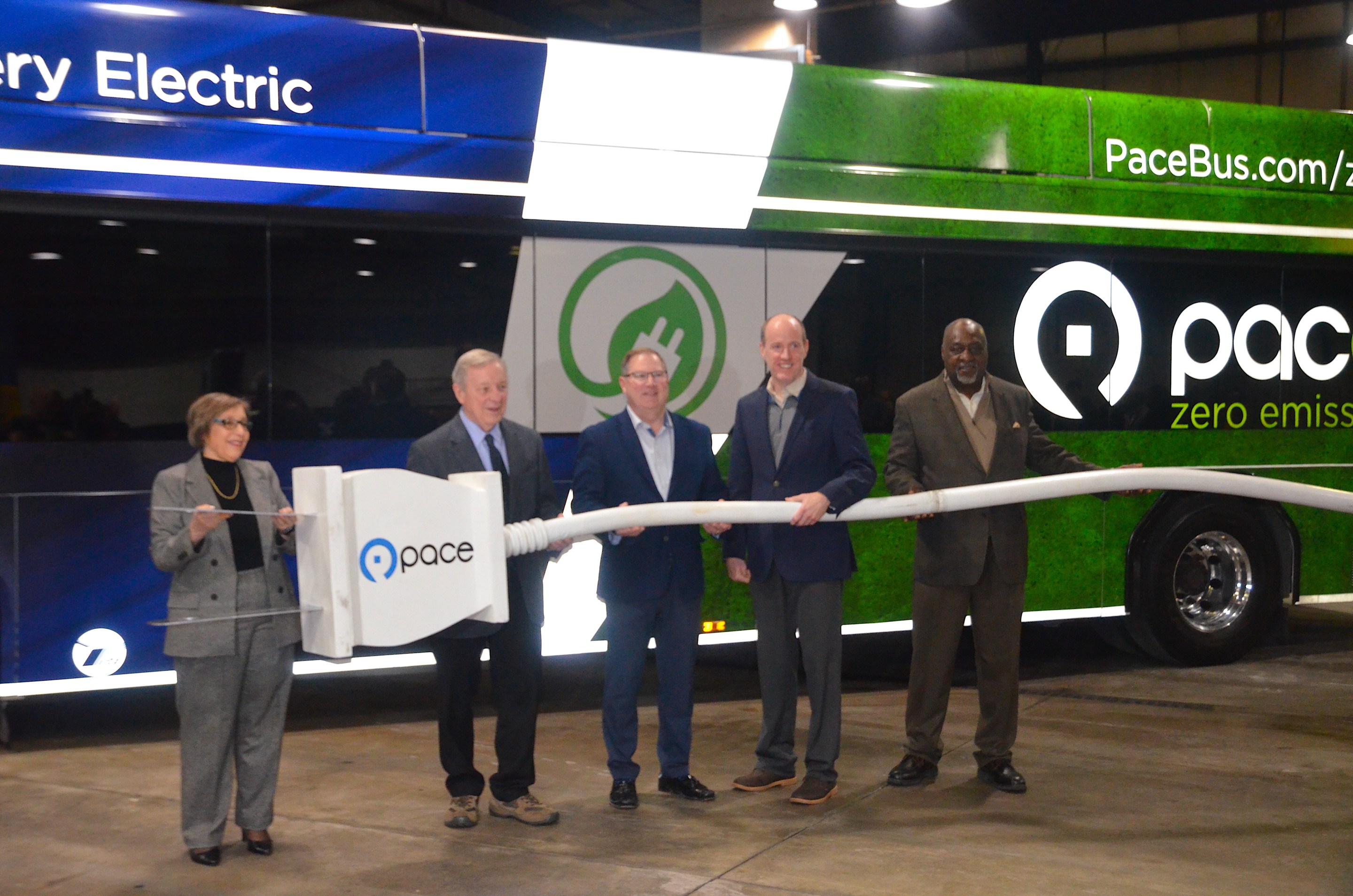
While electrifying bus fleets is a worthwhile goal, it shouldn't be prioritized over providing reliable, fast, and frequent bus service. Creating dedicated, camera-enforced lanes for pre-paid bus rapid transit service is a heavier political lift than bus electrification, because bus-only lanes take road space away from private vehicle drivers. But even gasoline-powered buses are effective for fighting climate change, if they're dependable enough to significantly reduce the number of private car trips. -JG
Pace Suburban Bus' very first fully electric bus debuted on its South Side / Southwest suburban Route 381 last Friday, with U.S. Senator Dick Durbin, Illinois State Senator Bill Cunningham (D-18th) and Chicago area transit officials on hand to see it off. The bus line runs largely on 95th Street.
Longtime Streetsblog readers may recall that Pace launched a diesel-electric bus pilot in north suburban Highland Park back in 2012, but the project never expanded beyond those two buses because the transit agency felt the expenses nullified the savings. Instead, it invested in Compressed Natural Gas buses, which run on cleaner-burning alternative to diesel, but still aren’t as clean as electric buses.
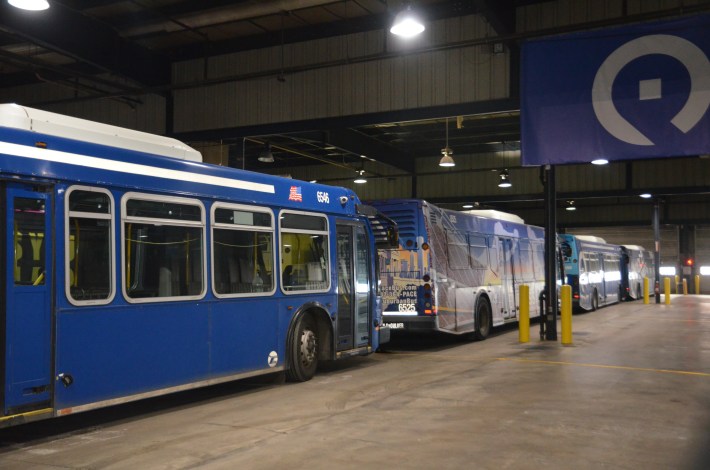
Pace shifted course in 2021. As part of its Driving Innovation strategic plan, it set the goal of going zero-emission by 2040. Its North Division, which serves routes at and near Waukegan, was supposed to be the first division to get the electric buses. Pace Executive Director Melinda Metzger told Streetsblog this is still priority, but the transit agency decided to bring the first all-electric bus to Route 381 because Southwest Division garage was already due for an upgrade to accommodate the planned Pulse Arterial Rapid Transit service along the route, so it made sense to put in the infrastructure necessary to charge and maintain the electric buses as well.
Getting the funding to buy the buses is still an issue. But Metzger indicated that the recent negative temps proved that the electric vehicles could stand up to the harsh Chicago winters.
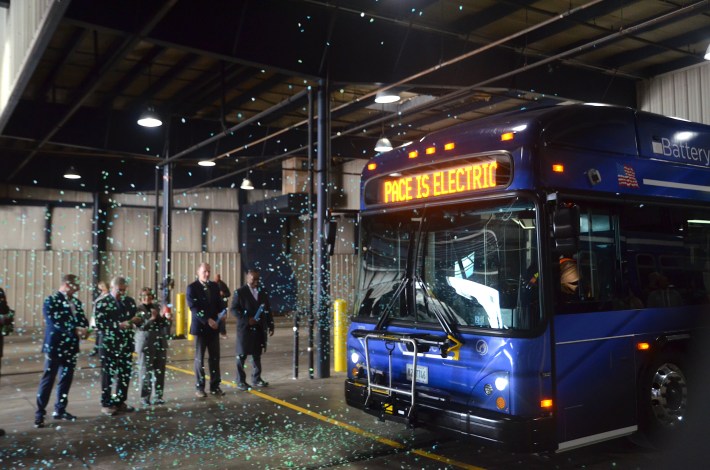
To mark the launch of the new bus, the dignitaries assembled in the Southwest Division bus garage in southwest suburban Bridgeview. Instead of cutting a ribbon, they posed with an oversized electric plug, and staff launched confetti as the bus left the garage. According to Pace, the bus simply took a loop around the area – it wouldn’t begin service until later that afternoon.
The corridor
Route 381 runs between the 95th/Dan Ryan Red Line terminal and Palos Hills’ Moraine Valley College. The route serves the Far South Side’s Washington Heights and Beverly neighborhoods, and the suburbs of Evergreen Park, Oak Lawn, Chicago Ridge, Bridgeview, and Hickory Hills.
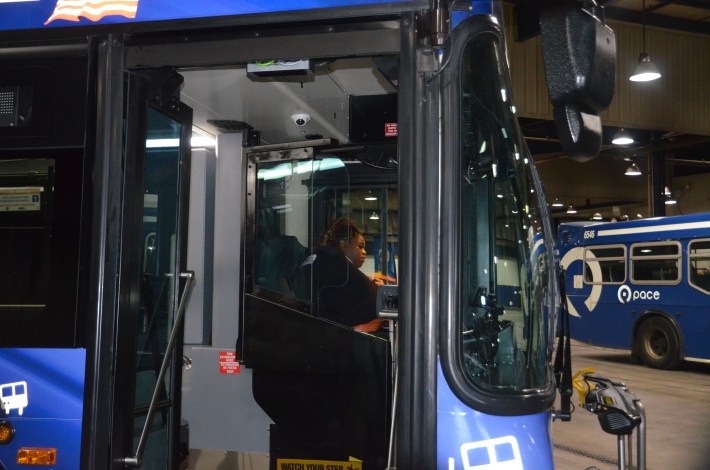
Pace indicated that the new electric bus, which it bought back in November 2022, will mostly be used on that route. But it isn’t unusual for Pace to direct vehicles to whichever route within the division happens to need it. So the e-bus might show up on one of the other seven routes that operate out of the garage and serve the surrounding suburbs. Notably, one of those routes is Route 390, which runs along Cicero Avenue on the Southwest Side past Midway Airport, serving shift workers at UPS’ Hodgkins facility. It's one of only a handful of Pace routes that runs in the middle of the night.
Electric vehicles tend to lose charge quicker in cold weather. Metzger told Streetsblog that the Pace field-tested the e-bus during the negative-digit temperatures that hit Chicago area earlier last week, and said "It didn’t have that big of an impact."
Pace spokesperson Maggie Daly Skogsbakken told Streetsblog the new bus posed a learning curve for both the drivers and the mechanics, but they were ready. "We’re excited to get people on board and see how it operates [with actual passengers," she said.
In his remarks during Friday's launch, Pace board chair Rick Kwasneski described the bus as a "tremendous milestone" in making the bus fleet zero-emission. "Already, 22 more electric buses are on order thanks to federal funding. We thank you, Senator Durbin, and the Illinois delegation for your support in this endeavor."
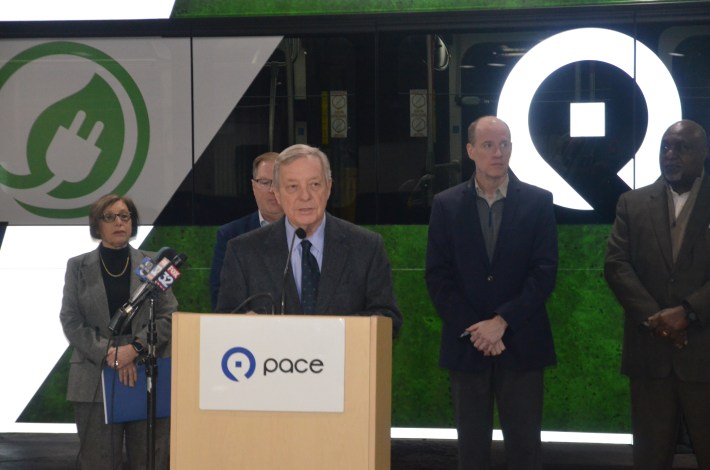
Durbin said that, while federal earmarks get a bad rep, the bus right behind him was an example of the good they could do. "When it comes to the people of the State of Illinois, I think we have a better sense of [what they need] than the wonderful public servants in Washington D.C.," he said.
Cunningham, whose district includes much of the Southwest Division territory, said that while coal power plants used to be the biggest polluters in Illinois, diesel emissions from trucks and buses have since taken on a bigger share. "I’m happy to see that Pace is committed to helping to change that," he said.
Michael Lewis represents southwest suburban Cook County on the Regional Transportation Authority board. "Transportation, public transportation, is the key factor to the growth and success of the Northeast Illinois. We’re excited about having more [energy-efficient] transportation offered to our customers in this area."
The future of electric buses
According to a Pace fact sheet, the transit agency expects to spend around $840 million to buy 700 electric buses (or roughly $1.2 million per bus). It plans to spend an additional $1.498 billion to convert the existing facilities, with $92 million of that going toward converting the North Division garage.
The major aspect of the upgrade is the power requirements. Pace will need to expand the electrical service capacity to accommodate almost three times as much electricity.
Pace obtained federal funding to buy six electric buses: a fixed-route bus for the North Division and five paratransit buses. It also ordered 22 buses for the North Division, and they are expected to arrive later this year. Daly Skogsbakken acknowledged that supply is an issue, because "everyone in the country wants to convert to electric" and there are only so many electric bus manufacturers around to satisfy the demand. She said that Pace will continue looking for federal funding to buy more buses where it can.
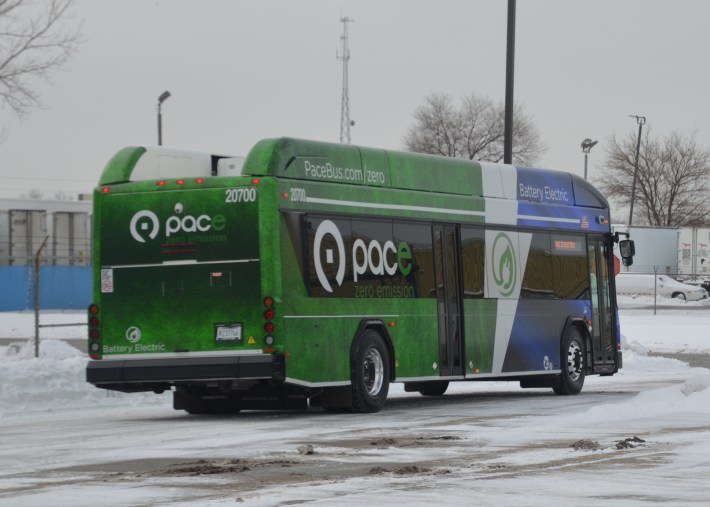
Part of the challenge is that Pace is ordering several different types of buses – the fixed-route buses, the smaller paratransit buses, and the coach-style buses for I-55/Stevenson rush hour Bus on Shoulder service.
And Pace hasn’t completely given up on Compressed Natural Gas buses. Back in back in 2018 when the transit agency originally talked about moving the Northwest Division garage from Des Plaines to a brand-new, larger facility in Wheeling, it was meant to be the transit agency’s second CNG garage. Since then, plans shifted, with Pace buying the building on the old Allstate campus in order to convert it into a garage suitable for electric and CNG buses. The Northwest Division includes the two existing Pulse lines.
The conversion budget includes $103 million of that would go into the new garage. “[CNG] buses travel the farthest," Metzger said, adding that Pace is looking at hydrogen fuel cells to replace them on the long run. "Technology is changing so quickly we don’t know what the future is going to hold," she said. "Our plans are changing all the time as technology gets greater."

Did you appreciate this post? Please consider making a tax-deductible donation to help Streetsblog Chicago keep publishing through 2025. Thank you.
